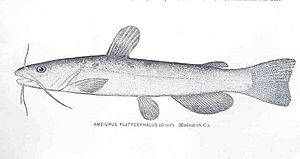Flat bullhead facts for kids
Quick facts for kids Flat bullhead |
|
|---|---|
 |
|
| Conservation status | |
| Scientific classification | |
| Synonyms | |
|
The flat bullhead (scientific name: Ameiurus platycephalus) is a type of catfish found in freshwater. This fish lives in the southeastern United States. You can find it from Virginia all the way down to Georgia.
Flat bullheads are usually about 23 centimeters (9 inches) long. The biggest ones can grow up to 29 centimeters (11 inches) long.
Contents
Where the Flat Bullhead Lives
The flat bullhead is native to the southeastern United States. This means it has always lived there. It can be found in rivers and streams that flow into the Atlantic Ocean. Its home stretches from the James River and Roanoke River in Virginia. It also lives as far south as the Altamaha River in Georgia.
This fish is common in many areas, like all the river systems in South Carolina. Flat bullheads like calm, slow-moving parts of rivers. They often live where the bottom is muddy or sandy. They can also be found near rocks covered with plants or other natural material.
You might also spot them in lakes, ponds, and behind dams. Younger flat bullheads prefer clear streams.
What Flat Bullheads Eat and How They Grow
Flat bullheads are not picky eaters! They munch on many different things. Their diet includes insects that live in the water. They also eat small snails and other shellfish. Sometimes, they even eat tiny fish.
They also eat plants and decaying bits of nature. Female flat bullheads are ready to have babies when they are about three years old. They lay their eggs during the summer months. A single female can lay anywhere from 200 to 1,740 eggs!
Protecting the Flat Bullhead
People do not usually catch flat bullheads for food. However, this fish faces some challenges. Two other types of catfish, the flathead catfish and the blue catfish, have been introduced to the flat bullhead's home. These new fish are predators, meaning they hunt and eat flat bullheads.
Other problems for the flat bullhead include water pollution. This happens when harmful substances get into the water. Sedimentation, which is when too much dirt and sand build up, can also harm their habitat. Dams and changes in water quality also affect them.
Even though it is not a very common fish, the flat bullhead lives in a wide area. Because of this, the International Union for the Conservation of Nature (IUCN) says it is a species of "least concern". This means it is not currently in danger of disappearing.
See also
 In Spanish: Ameiurus platycephalus para niños
In Spanish: Ameiurus platycephalus para niños


